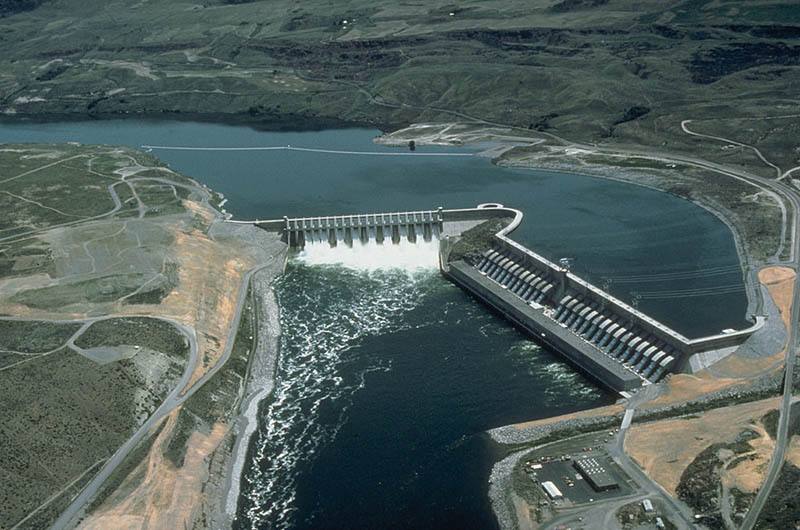This is not renewable energy:

Nor is this some clever, Magritte-esque meta-commentary on how it is impossible represent or think about renewable energy separate from the technologies that harness it. No, it is simply an issue of taxonomy: hydropower is only counted as “renewable” some of the time.
This is confusing, because if the term “renewable” has any meaning, after all, it is first and foremost a description of a process, one that specifically refers to the fact that the natural resource from which said energy is produced either does not significantly deplete upon use to begin with, or can be easily replenished within a human time scale. Hydropower, harnessed through the most abundant substance on our “blue planet”, seems to easily fit the description, which makes the exception worth exploring.
Classifying Small Hydro
In India, where I conduct fieldwork among solar energy practitioners and attend to the intricacies of renewable energy policy, hydro’s anomaly is embedded into the very highest levels of the policy structure. As a country that embraced hydropower with some gusto in the 1950s, soon after independence, dams fell under the purview of the original Ministry of Power. Consequently, hydro was regulated alongside the conventional sources—coal and oil. And there, in some form, it remains, despite the formation of another ministry—the Ministry of Non-Conventional Energy, in 1992 (later re-named the Ministry of New and Renewable Energy). The old Ministry continues to regulate large dams; the new ministry regulates what it designates as “small hydro”, defined on its website as projects generating less than 25 megawatts of power.
India’s somewhat eclectic ministry structure aside, the convention represented by the distinction—big vs. small—is more-or-less internationally accepted. Large hydro, or mega dams, are (largely) excluded from the pantheon of renewables-related calculations and claims because of their adverse social and ecological side-effects. These include displaced populations, destroyed river and soil ecosystems, and even—as scientists discovered a few years ago—a slow emissions build-up from decaying organic matter in reservoirs.
Perhaps, then, the take-away from hydro’s dual status as a simultaneously renewable and not-renewable energy is that “renewable” is not so much a descriptive term as it is simply an ideological classification. And like all classifications, it comes with a set of precepts – in this case, scalar. To paraphrase the famous E.F Schumacher (whose influential book, by no coincidence, released the same year the world experienced its first “oil shock”): small is renewable. Doing a little more research on the details of said classification, however, reveals that while the big/small distinction upon which the definition rests is broadly agreed upon, the actual scales vary quite drastically. The UN Environment Programme defines small hydro as less than 50 megawatts; as we have seen, in India this number is 25 megawatts. Expanding the inquiry only throws up more discrepancy: the European Union classification of “small” is 10 megawatts, although some countries like Sweden go even smaller, defining it at 1.5 megawatts.
Renewable as Threshold
The fragmentation, though confusing, points to another way of approaching “renewable”—not just as a description, or simply a classification, but as a threshold. If renewability does not often appear as such, it is because it is politically and ideologically set up as a binary: energies are either renewable, or they are “non-”. Thresholds can be devices through which binaries are defined, but at the same time reveal the socially constructed nature of such definition. Most commonly within environmental discourse, “tipping points” are scientifically designated boundary conditions between one and another “state” beyond which change is both certain and worrisomely unpredictable. While thresholds produce conditions within which to conceptualize binary states (“before” and “after”), they do so with an additional layer of nuance.
What would our environmental politics look like, then, if we started treating the term “renewable” conceptually not just as a descriptor but as a threshold? To begin with, the moniker would be less of a given and would call for greater burden of proof: one that exceeds the specificities of the technologies, and bleeds much more into the contexts of use. But it could also allow us to nuance the moral space from which renewability becomes an all-encompassing symbol for a progressive politics (cf. the Green New Deal). Thresholds might enable us to hold on to such (much needed) progressivism while creating the space to acknowledge that these technologies and the contexts in which they are deployed often represent not the best-case scenario so much as variations on the least-possible-worst case scenario: a distinction which, at the very least, more accurately represents most political and environmental calculation today.
References
